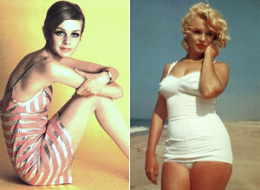From body image to body dysmorphia
The way we look to ourselves and the outside world is for an important part driven by media.
If we go back in time, we mostly call certain looks to a decade. The fifties brought the “Rock and roll” and Elvis retro-style hair. When I think “sixties” I see long hair, hippies, free love, a lot of flowers and a distinct music. Its was followed by “ Punk “. People follow a certain code in fashion, hairstyle, music etc.
As long as it comes to fashion or hairstyles, most people can adapt to these unwritten rules, mostly the younger people are very eager to be accepted, you’re “in” or “out”, in the sixties you where either “hip” or not, now the magic word is “cool”. What if this typation involves our body-image?
 In the mid-sixties the most admired look changed from Hollywood icon Marilyn Monroe to a British fashion model called “Twiggy”. The most wanted body type changed from a fully curved voluptuous blond model to a boyish thin girl.
In the mid-sixties the most admired look changed from Hollywood icon Marilyn Monroe to a British fashion model called “Twiggy”. The most wanted body type changed from a fully curved voluptuous blond model to a boyish thin girl.
Whether you're thin, fat, small, dark, blond, redhead, you wanna be something else," said the world's first boldface supermodel. "I wanted a fairy godmother to make me look like Marilyn Monroe. I had no boobs, no hips, and I wanted it desperately."
Since then the fashion markets unnatural cq unhealthy thin models. To achieve this look , mostly very young, girls develop an unnatural eating behaviour from diet pills to bulimia and anorexia. The first signs of body dysmorphia embodied in eating disorders.